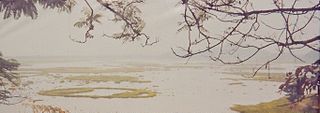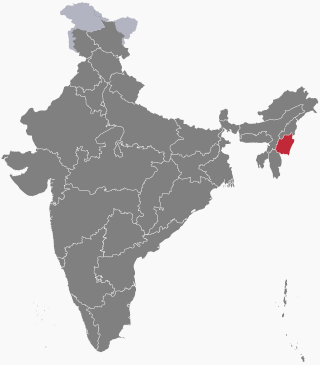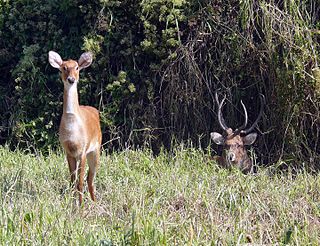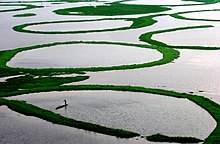
Manipur is a state in northeast India, with the city of Imphal as its capital. It is bounded by the Indian states of Nagaland to the north, Mizoram to the south and Assam to the west. It also borders two regions of Myanmar, Sagaing Region to the east and Chin State to the south. The state covers an area of 22,327 km2 (8,621 sq mi). The official and most widely spoken language is the Meitei language. Native to the Meitei people, it is also used as a lingua franca by smaller communities, who speak a variety of other Tibeto-Burman languages. Manipur has been at the crossroads of Asian economic and cultural exchange for more than 2,500 years. This exchange connects the Indian subcontinent and Central Asia to Southeast Asia, East Asia, Siberia, regions in the Arctic, Micronesia and Polynesia enabling migration of people, cultures and religions.

Eld's deer, also known as the thamin or brow-antlered deer, is an Endangered species of deer endemic to South and Southeast Asia. It inhabits wetlands and marshlands. It is active during the day and mates from October to the end of December. Three subspecies are recognised. All three are threatened by hunting and deforestation.

Loktak Lake is a freshwater lake in Northeast India. It is a pulsating lake, with a surface area varying from 250 km2 to 500 km2 during the rainy season with a typical area of 287 km2. The lake is located at Moirang in Manipur state, India. The etymology of Loktak is Lok = "stream" and tak = "the end" in Meitei language. It is famous for the phumdi floating over it. The largest of all the phumdis covers an area of 40 km2 (15 sq mi) and is situated on the southeastern shore of the lake. Located on this phumdi, Keibul Lamjao National Park is the only floating national park in the world. The park is the last natural refuge of the endangered Sangai, Rucervus eldii eldii or Manipur brow-antlered deer, one of three subspecies of Eld's deer.

The Keibul Lamjao National Park is a national park in the Bishnupur district of the state of Manipur in Northeast India. It is 40 km2 (15.4 sq mi) in area, the only floating national park in the world, and an integral part of Loktak Lake. It is currently under the tentative lists of the UNESCO World Heritage Sites, under the title "Keibul Lamjao Conservation Area (KLCA)", additionally covering the buffer of Loktak Lake and Pumlen Pat.

Moirang is a town in the Indian state of Manipur, best known for the tentatively listed UNESCO World Heritage Sites of the Keibul Lamjao Conservation Area (KLCA), covering Keibul Lamjao National Park (KLNP), the world's only floating national park, the buffer of Loktak Lake and Pumlen Pat. It is best known for the being the place of origin of the ancient epic legend of Khamba and Thoibi, one of the seven epic cycles of incarnations of Meitei mythology and folklore. Nationwide, it is also famous for the INA War Museum in the INA Martyrs' Memorial Complex, where Colonel Shaukat Malik of the Indian National Army hoisted the Tricolour for the first time on Indian soil on 14 April 1944. It is situated approximately 45 km (28 mi) south of the state capital Imphal. It has an area of 269 km2 (104 sq mi) with a population of 62,187 in 67 villages. There are 12 Panchayats in this block.

The sangai is an endemic and endangered subspecies of Eld's deer found only in Manipur, India. It is also the state animal of Manipur. Its common English name is Manipur brow-antlered deer or Eld's deer. Its original natural habitat is the floating marshy grasslands of the Keibul Lamjao National Park, located in the southern parts of the Loktak Lake, which is the largest freshwater lake in South Asia.

Phumdi, also known as Phumthi or simply Phum, are a series of floating islands, exclusive to the Loktak Lake in Manipur state, in northeastern India. They cover a substantial part of the lake area and are heterogeneous masses of vegetation, soil and organic matter, in different stages of decay. The largest single mass of phumdi is in the southeastern part of the lake, covering an area of 40 km2 (15.4 sq mi). This mass constitutes the world’s largest floating park, named Keibul Lamjao National Park. The park was formed to preserve the endangered Eld's deer subspecies, called sangai in the Meitei language, indigenous to this area.
Toubul is a village in the Bishnupur district of Manipur, India, with a total population of around 4044 people as per the 2001 census. The village is surrounded by farmlands in the west, north, and south, and by Loktak Lake in the east. Farming and fishery are the main sources of livelihood for the residents. However, Toubul is also one of the most affected villages due to the hydroelectric power generation plant from Loktak lake, which happens to be the biggest freshwater lake in north-east India.

Northeast India consists of eight states: Arunachal Pradesh, Assam, Manipur, Meghalaya, Mizoram, Nagaland, Sikkim and Tripura. Tourism in this area is based around the unique Himalayan landscape and culture distinct from the rest of India.

The Sekta Archaeological Living Museum is a museum in Sekta village in the Indian state of Manipur. It is a protected archaeological site which is one of the six mounds identified in the area. It is known for its secondary burial finds. This site was excavated by the Archaeological Survey of India in association with the State Archaeology Department of Manipur. The Department of History of the Manipur University was also associated with the excavations carried out in 1991.

The following outline is provided as an overview of and topical guide to Manipur:

Maharaj Kumari Binodini Devi was a writer from the Northeastern Indian state of Manipur. She wrote in Meiteilon under the mononym Binodini. She was best known for her 1976 historical novel Boro Saheb Ongbi Sanatombi, which won the Sahitya Akademi Award in 1979. Its English translation, ThePrincess and the Political Agent, was published as a Penguin Modern Classic in 2020 by Penguin Random House India.

Manipur Zoological Garden is a zoo in Iroisemba, Manipur. It is the second habitat of Sangai, the world's only dancing deer species, after the Keibul Lamjao National Park, the world's only floating national park. It is a medium sized zoological garden. It houses Schedule 1 species of amphibians, birds, mammals and reptiles. The animals kept in the zoo are mostly endemic to Manipur. The Central Zoo Authority of India recognized it as the coordinating zoo for the conservation breeding center of Sangai and Serow.

The Khonghampat Orchidarium is a botanical garden in Imphal, Manipur, India. It is dedicated to the collection, cultivation, preservation and display of a wide range of 500 varieties of orchids found in Manipur. It houses some of the rarest orchids in the world. The peak blooming season of the orchid flowers is from April to July. The finest visiting season is March to April. This Orchidarium is the orchid centre of the Forest Department of Manipur.

The Loktak Folklore Museum or the Thanga Folklore Museum is a folk museum in Thanga Island in the Loktak lake of Manipur, India. It cares for and displays a collection of artistic, cultural and historical artefacts associated with the Loktak lake. The museum preserves the folk customs and beliefs, folk medicines, folk literature associated with the Loktak lake.

The INA War Museum or the Indian National Army War Museum is a WWII museum in Moirang, Manipur. It is the only official WWII museum in Manipur though many other WWII museums are opened in the state. This museum is situated inside the INA Memorial Complex. The museum focuses primarily on the rise of the Indian National Army (INA) and the contributions of Subhash Chandra Bose to the Indian independence movement. This museum is the only official museum dedicated to Netaji Subhash Chandra Bose.

The ancient legend of Kadeng Thangjahanba and Tonu Laijinglembi is an epic cycle of incarnations of Meitei mythology and folklore from Moirang kingdom of Ancient Kangleipak. It concerns the fateful love of Kadeng Thangjahanba, a skilled blacksmith, for the beautiful Tonu Laijinglembi.

Animals have significant roles in different elements of Meitei culture, including but not limited to Meitei cuisine, Meitei dances, Meitei festivals, Meitei folklore, Meitei folktales, Meitei literature, Meitei mythology, Meitei religion, etc.





















